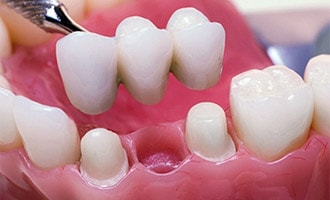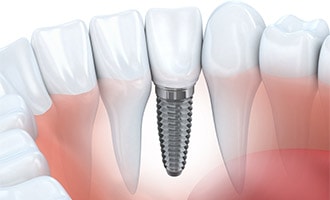A dental bridge is a series of connected crowns used to fill a gap left by one or more missing teeth. To give the bridge its support, the outer crowns on each end of the bridge are placed over the teeth adjacent to the gap. Dental bridges are a fast and economical way to replace a missing tooth, and require no surgery.
Dental Bridge Procedure Details
Dr. Ahmed Manassra is a specialist in designing, fabricating and placing dental bridges. He crafts his bridges from a number of high-quality materials, and will select which material to use based on your specific needs. Regardless of the materials used, your bridge will fit comfortably, align perfectly with the rest of your bite and look natural in your smile.
Placing a bridge requires that the teeth on each side of the gap be shaved down slightly so the bridge can be placed over them. This can reduce the strength of those teeth, so Dr. Ahmed Manassra makes sure these teeth have healthy gum support before placing a bridge. In this way he ensures that the dental bridge will be long-lasting.

To fabricate a bridge that will be natural-looking and long-lasting, Dr. Ahmed Manassra uses a local dental lab known for producing high-quality restorations that meet his exact specifications. The lab can create a durable and natural-looking bridge from any material he requests, and can precisely match the shade of your other teeth. If needed, a lab technician will see you in person to ensure an exact shade match.
Dental Implants Compared to Dental Bridges
Dental implants are another option for replacing missing teeth. Dental implants are titanium posts inserted into the jaw to act as replacement roots. They are either topped by individual crowns or used to support a dental bridge. Dental implant-supported teeth are very strong and long lasting. They look, feel and function just like natural teeth. You can brush and floss with them just as you would with any other tooth. They also don’t require grinding down of adjacent teeth. When the teeth next to a gap are healthy, dental implants are a better option for replacing the missing tooth or teeth.
Dental implant placement is a surgical procedure and an implant requires adequate bone support to be stable. Sometimes bone grafting may be needed at the implant site to provide the needed bone support. Dental bridges don’t require any bone grafting procedures.

A dental bridge is a faster and more economical option for replacing a missing tooth, as dental bridges require no surgery in order to be placed. Dental bridges can be a good option when the adjacent teeth are in need of restoration themselves or when major bone grafting would be required to place an implant.
Dental bridges reliably replace missing teeth to restore your confident smile. At Manassra Dental Specialists, Dr. Ahmed Manassra and our team understand the importance of maintaining a healthy, functional smile, and we’re here to help you explore the best options for your dental needs.
Here, we delve into some of the most frequently asked questions about dental bridges.
What Are the Types of Dental Bridges?
Dental bridges come in several types, each tailored to different dental situations:
- Traditional Bridges: Traditional bridges include at least one artificial tooth. Crowns connected to each side fit over your natural teeth and keep the artificial tooth securely in place.
- Implant-Supported Bridges: These bridges are anchored to dental implants rather than natural teeth, providing exceptional stability and longevity.
- Cantilever Bridges: Cantilever bridges are like traditional ones but only use one extra crown. It attaches to the tooth on the right or left of your missing tooth. They may be ideal for specific placements.
- Maryland Bridges: Instead of crowns, Maryland bridges have a metal frame that attaches to the back of a neighboring tooth. The bridge connects to that frame.
Dr. Manassra expertly assesses your unique needs and recommends the right type of bridge for you. Most patients get traditional or implant-supported bridges today, as they provide excellent stability and durability.
What Are the Most Common Misconceptions About Dental Bridges?
Despite their effectiveness, dental bridges are sometimes misunderstood. Here are a few misconceptions we frequently hear:
- “Dental bridges are only cosmetic.” While they improve your smile, dental bridges restore functionality, making eating and speaking easier.
- “Dental bridges don’t last long.” Dental bridges can last 10-15 years or longer with proper care, proving they’re a long-term investment in oral health.
- “Bridges damage healthy teeth.” Modern techniques and materials ensure minimal impact on natural teeth, especially with implant-supported bridges.
Our team helps patients understand how dental bridges can meet their needs and fit into their lives.
How Do I Care For My Dental Bridge?
It’s easy to take care of your dental bridge. Some of our top tips for maintaining its longevity are:
- Brushing: Brush your teeth twice daily (two minutes per session) with fluoride toothpaste, cleaning carefully around the bridge, especially at the gum line.
- Flossing Daily: When you wear a bridge, it’s important to floss carefully to avoid dislodging it. A “threader” is a flexible plastic tool with a loop at the end. It helps move dental floss safely around dental bridges. You thread the floss through the loop to floss safely and comfortably. Many people with braces also use this flosser to keep their teeth safe during flossing.
- Avoid Damaging Foods: Avoid hard foods, like ice or hard candy, and very chewy foods, like sticky caramel, as they can pull on and damage your bridge over time.
- Regular Checkups: Regular checkups at Manassra Dental are one of the best ways to ensure your bridge stays secure and in excellent condition. Dr. Ahmed Manassra takes the time to examine your entire mouth carefully and ensures your oral health is in great shape.
Can a Dental Bridge Be Repaired if It’s Damaged?
Yes, in many cases, a damaged dental bridge can be repaired. Contact us immediately if your bridge becomes chipped, loose, or cracked.
Dr. Ahmed Manassra can often repair minor damage, like chips, using dental bonding. More extensive damage might require replacing one or several crowns within the bridge.
Dr. Ahmed Manassra always seeks to repair your existing bridge if at all possible. In many cases, you won’t need a full replacement.
Can Anyone Get a Dental Bridge?
Most people are candidates for dental bridges, but certain factors determine their suitability:
- You need to have healthy adjacent teeth or implants to support the bridge.
- If you have gum disease or tooth decay, Dr. Ahmed Manassra must treat those problems first.
- If you’re missing multiple teeth, implant-supported bridges may be the best option for long-term stability.
During your consultation, we comprehensively evaluate your oral health and recommend the best solution to restore your smile.
What Are the Benefits of Dental Bridges?
Dental bridges offer several benefits that improve both your oral health and quality of life:
- Restored Functionality: They make it easier to chew and speak naturally.
- Enhanced Appearance: Bridges fill gaps, preventing the sunken look that can occur with missing teeth.
- Prevention of Shifting Teeth: Bridges prevent neighboring teeth from moving out of place by filling the gap.
- Improved Confidence: A complete smile can boost your self-esteem and comfort in social settings and personal life.
Why Choose Us for Your Dental Bridge?
At Manassra Dental, we provide personalized care that meets your unique needs. Dr. Ahmed Manassra and our experienced team use advanced techniques and high-quality materials to ensure your dental bridge looks, feels, and functions naturally. We’ll work with you every step of the way to help you achieve a healthy, beautiful smile.
Schedule Full Examination to Determine Available Options
Dr. Ahmed Manassra will conduct a comprehensive oral exam to determine your available options for tooth replacement. He will carefully explain the pros and cons of each option as it applies to your situation, will give you his recommendation and will answer all of your questions. In this way you can make a comfortable and well-informed decision about your treatment.